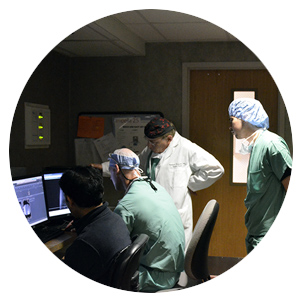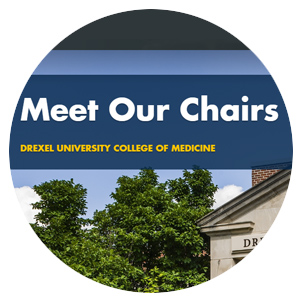Short Report - What's News?

Ellen Garven spent a lot of time looking over shoulders at Hahnemann University Hospital last year.
That's because the PhD student in Drexel's School of Biomedical Engineering, Science and Health Systems chose to take BMES-596 — a clinical practicum in which biomedical engineering students can observe basic operative procedures and see the role biomedical engineers can play in improving surgical practice.
"Walking into the OR for the first time was nerve-wracking," she says. "Was I going to get grossed out and leave the room?" But that didn't happen. Instead, Garven says, she learned that "observing and working with surgeons to develop better tools is something I would enjoy doing."
Garven also saw a lot of gruesome pictures at 8 a.m. That's because the lecture portion of the class, taught by David Stein, MD, chair of surgery in the College of Medicine, introduces the biomedical students to the variety of surgical procedures and best practices they will come across in their observations.
"It's very nice to study something theoretically, but without practical experience, it's harder to learn," Stein says of the class. "This is a way, in a structured environment, where they can learn some of the basics about surgical care and the surgical specialties, but also get their hands wet on what it's like to be in an operating room."
The culmination of the class is a project in which each student presents an idea for a new biomedical device that solves a problem they witnessed during their observations. A panel of College of Medicine faculty, including the Department of Surgery's two biomedical engineers, provides feedback.
Garven says she found it funny when she saw an article promoting "hands-on learning" in another biomedical engineering program, but it was just something simulated in a classroom. "It was very not real-world," she says. "It's nothing compared to actually going and seeing it being done."
Back to Top

Ria Mulherkar, editor-in-chief of The Tincture, a student-run art and literary journal, writes, "The daily business of medicine often leaves us encumbered with facts, thoughts, details. It keeps us ever occupied … In this fury of knowledge and reason, something vital often slips away — something that keeps us human.
"The Tincture was created so that we as medical students could stay in touch with that something human. It is a way of tending to the heart and soul while our learned minds continue to grow."
The 2018 issue, the third in this annual series, is filled with art in many forms, all generated by the very talented student body. Read in magazine format at issuu.com/thetincture/docs/tincture2018contentdraft4 or visit tincturemagazine.com.
Back to Top

New on the web: Meet the chairs of the College of Medicine's four basic science and 17 clinical departments. Scroll through brief bios of this distinguished group, or link to their full profiles to see other accomplishments. Six department chairs are alumni: Drs. Richard Hamilton (Emergency Medicine) and Owen Montgomery (Ob/Gyn) earned their medical degrees from Hahnemann; Lydia Komarnicky, MD (Radiation Oncology), from MCP; and Drs. Peter Gliebus (Neurology), Michael Green (Anesthesiology) and Wei Du (Psychiatry) completed Drexel/Hahnemann residencies. Visit bit.ly/ducomchairs/.
Back to Top
More than 18,000 scientific papers and conference presentations have been retracted since the 1970s, according to an industry blog called Retraction Watch. Now, with the recent debut of a searchable online database compiled by RW, information on those retractions is available with the click of a mouse.
Each title is listed with author, publisher, subject, dates of publication and retraction, and country of origin. Perhaps most important, each listing also includes the impetus for the retraction — more than half are the result of fabrication, falsification or plagiarism. Another 10 percent result from other unethical behaviors. Nearly 40 percent arise from honest errors, problems with reproducibility or other unintentional issues.
In an analysis of the data, Science magazine noted that the number of retractions has risen substantially in recent years, from fewer than 100 per year before 2000 to nearly 1,000 in 2014. Still, the rate of retraction is relatively low, about four in 10,000 papers. And much of the increase in numbers appears to reflect improved oversight at a growing number of journals.
Interestingly, individual bad actors account for a disproportionate number of retractions. Just 500 of more than 30,000 authors and co-authors named in the database — less than 1.7 percent — account for about one-quarter of the 10,500 retractions that Science analyzed. And 100 of those authors were responsible for 13 or more retractions each. Science notes: "Those withdrawals are mostly due to deliberate misconduct, not errors."
Retraction Watch was founded by the journalists Ivan Oransky and Adam Marcus. They have received funding from multiple sources, most notably the MacArthur Foundation and the Arnold Foundation.
Back to Top
Most of us have learned to accept that we are targeted by advertisers based on our online and other behaviors. Now, thanks to smart thermometers, your ZIP code can be targeted based on your health.
A company called Kinsa, founded by serial philanthropist Inder Singh, has developed internet-connected thermometers that sync to a phone app, allowing users to track their fevers and symptoms. The company aggregates deidentified data from the apps — geocoded by GPS or IP address — and uses it to track the spread of, say, influenza. The data can be valuable for marketing and could prove valuable for public health. For example, Clorox has licensed Kinsa data to identify ZIP codes around the country where fevers are spiking. The company then directs more digital ads for its disinfectant wipes to those areas. Other companies have used the data to keep retailers' shelves stocked with flu-related products in high-fever communities.
Meanwhile, according to a study published in Clinical Infectious Diseases that combined Kinsa data with data from the CDC, smart thermometers have the potential to offer public health benefits. The study found that "thermometer readings were highly correlated with national influenza-like illness (ILI) activity (r > 0.95) and activity patterns across regions and age groups. Thermometer readings also significantly improved forecasts of ILI activity in real time and up to 3 weeks in advance."
As the so-called "internet of things" expands into more and more corners of people's lives, some have voiced privacy concerns — perhaps with good reason. Amazon was granted a patent last fall for technology that will enable its Echo device to detect coughing or sniffling from voice input and respond by recommending cough drops or chicken soup. Other patents submitted by Amazon would result in Alexa making product suggestions based on keywords in people's conversations. Based on recurring anecdotes, some people believe their devices are already eavesdropping on them.
Back to Top

Tweet from the Laboratory of Jessica Barson, PhD: I'm pretty sure this has been said before, but can we all just agree, when writing letters of recommendation for women candidates, not to use words like "pleasant" and "agreeable"? It really just sounds like the writer is trying to say "they know their place."
Back Story: Barson, an assistant professor of neurobiology and anatomy, was reading through materials for graduate school applications in advance of meeting the candidates. More than one recommendation letter described a female applicant in those terms. "I never saw those words used in letters for male applicants," Barson says. "Of course, I would prefer not to work with someone who is unpleasant or disagreeable, but this should not affect my view of them as a scientist."
Back to Top